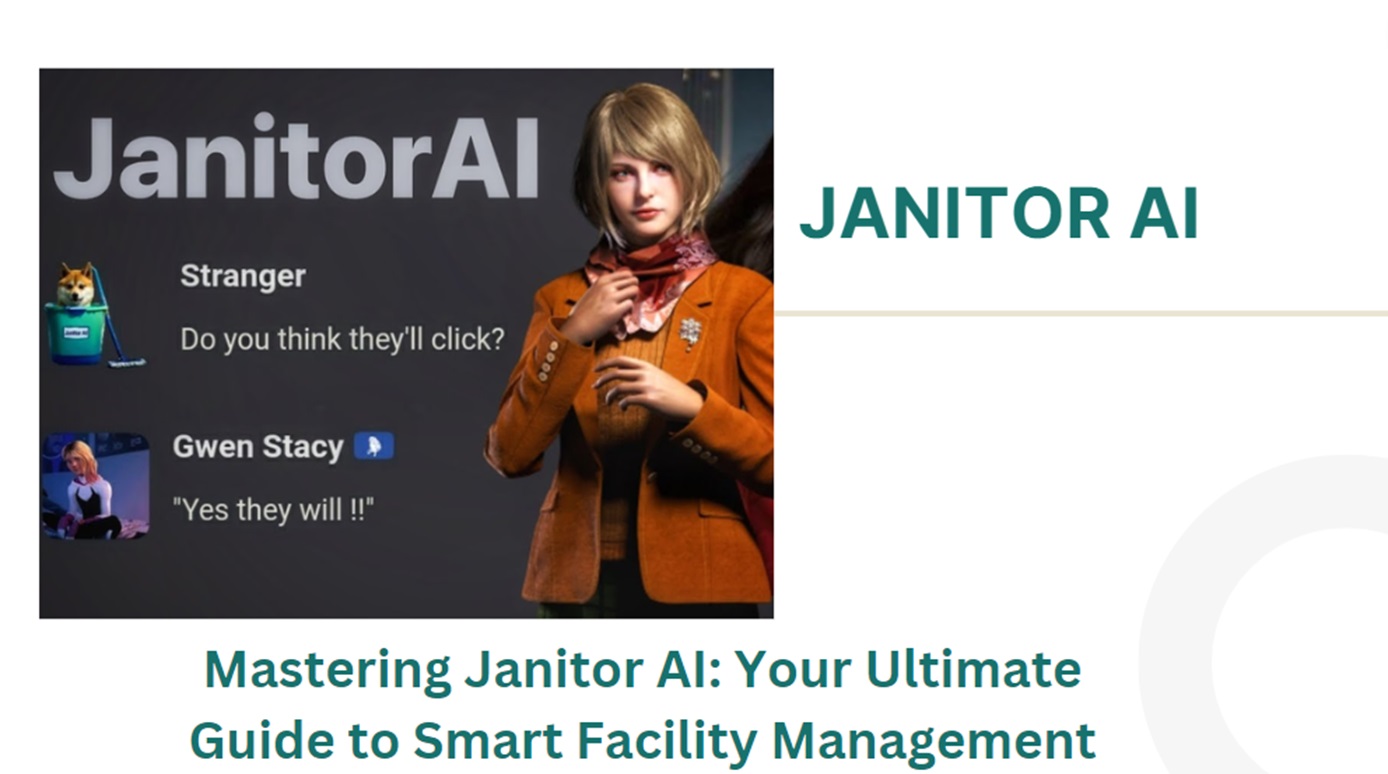
janitor ai
Introduction
Artificial Intelligence (AI) has become a cornerstone of technological advancement, revolutionizing industries and redefining the way we interact with machines. One of the fascinating developments in AI is the creation of specialized tools designed to handle specific tasks with remarkable efficiency. Among these, Janitor AI stands out as a unique and powerful tool, particularly tailored for maintenance and custodial management. This article provides an in-depth guide on how to use Janitor AI effectively, covering everything from its setup to advanced features.
Table of Contents
Understanding Janitor AI
Janitor AI is an advanced AI system designed to assist with various maintenance and custodial tasks within facilities. Leveraging machine learning and data analytics, Janitor AI can perform a range of functions, from routine cleaning schedules to predictive maintenance and resource management. It is equipped with features that enhance operational efficiency, reduce costs, and improve the overall cleanliness and functionality of facilities.
Key Features of Janitor AI
- Automated Cleaning Schedules: Janitor AI can create and manage cleaning schedules based on usage patterns, ensuring that areas are cleaned when needed without human intervention.
- Predictive Maintenance: By analyzing data from sensors and maintenance logs, Janitor AI can predict equipment failures before they occur, allowing for proactive repairs.
- Resource Management: The AI can track inventory levels of cleaning supplies and automatically reorder them when necessary.
- Real-time Monitoring: Janitor AI provides real-time monitoring of facilities, enabling immediate responses to issues such as spills or equipment malfunctions.
- Energy Efficiency: The system can optimize the use of energy resources, reducing waste and lowering operational costs.
Setting Up Janitor AI
System Requirements
Before setting up Janitor AI, ensure your facility meets the necessary system requirements. These typically include:
- Hardware: Sensors, cameras, and smart devices compatible with Janitor AI.
- Software: The latest version of the Janitor AI software suite.
- Internet Connection: A stable internet connection for real-time data transmission and updates.
Installation Process
- Hardware Installation: Begin by installing the required hardware throughout your facility. This includes sensors in key areas such as restrooms, kitchens, and high-traffic zones.
- Software Installation: Install the Janitor AI software on your central management computer. Follow the on-screen instructions to complete the setup.
- Integration: Integrate Janitor AI with existing systems such as HVAC, lighting, and security. This allows for comprehensive management and control.
- Configuration: Configure the software settings to match your facility’s specific needs. This includes setting cleaning schedules, maintenance alerts, and resource management protocols.
Initial Calibration
Once installed, calibrate the system to ensure accurate performance. This involves:
- Sensor Calibration: Test and adjust sensors to ensure they accurately detect environmental conditions.
- System Testing: Run initial tests to verify that the AI responds correctly to different scenarios.
- User Training: Train staff on how to interact with the system, including how to respond to alerts and use the management dashboard.
Using Janitor AI for Daily Operations
Creating and Managing Cleaning Schedules
Janitor AI’s automated scheduling feature is designed to optimize cleaning routines based on facility usage. Here’s how to make the most of it:
- Data Input: Input data regarding facility usage patterns, such as peak hours and high-traffic areas.
- Schedule Creation: The AI will generate an optimized cleaning schedule, which can be adjusted manually if needed.
- Execution: Janitor AI will automatically dispatch cleaning tasks to robotic cleaners or notify human custodians as per the schedule.
- Monitoring and Adjustment: Continuously monitor the effectiveness of the schedule and make adjustments based on feedback and changing conditions.
Predictive Maintenance
Predictive maintenance is a standout feature of Janitor AI, helping to prevent equipment failures and extend the lifespan of assets. Follow these steps to utilize this feature:
- Data Collection: Ensure all relevant data from sensors and maintenance logs are being collected.
- Analysis: Janitor AI will analyze this data to identify patterns that indicate potential issues.
- Alerts: The system will send alerts when it predicts a possible failure, allowing maintenance teams to address the issue before it becomes critical.
- Reporting: Regular maintenance reports can be generated to track performance and identify areas for improvement.
Resource Management
Efficient resource management is crucial for maintaining a clean and functional facility. Janitor AI assists with this by:
- Inventory Tracking: Automatically tracking inventory levels of cleaning supplies and other resources.
- Automatic Reordering: Reordering supplies when levels fall below a predefined threshold.
- Usage Reports: Generating reports on resource usage to help identify trends and optimize purchasing.
Advanced Features and Customization
Real-time Monitoring and Response
Janitor AI’s real-time monitoring capabilities ensure immediate responses to any issues that arise. This includes:
- Spill Detection: Sensors can detect spills and alert custodians immediately.
- Equipment Malfunction: The system can identify equipment malfunctions and notify maintenance teams.
- Environmental Conditions: Monitoring conditions such as humidity and temperature to maintain optimal settings.
Energy Efficiency Optimization
Janitor AI helps reduce energy consumption through smart management:
- HVAC Optimization: Adjusting heating, ventilation, and air conditioning based on occupancy and environmental conditions.
- Lighting Control: Managing lighting systems to ensure they are only used when needed.
- Energy Usage Reports: Providing detailed reports on energy consumption to identify savings opportunities.
Customization Options
Every facility has unique needs, and Janitor AI can be customized accordingly:
- Tailored Schedules: Adjust cleaning and maintenance schedules to meet specific requirements.
- Custom Alerts: Set up custom alerts for particular scenarios or conditions.
- Integration with Other Systems: Integrate Janitor AI with other facility management systems for a comprehensive solution.
Training and Support
Staff Training
For Janitor AI to be effective, staff must be adequately trained. This includes:
- System Operation: Teaching staff how to use the Janitor AI interface and respond to alerts.
- Maintenance Procedures: Training maintenance personnel on how to interpret predictive maintenance alerts and perform necessary actions.
- Regular Updates: Keeping staff updated on new features and improvements to the system.
Technical Support
Janitor AI providers typically offer robust technical support to assist with:
- Installation Issues: Helping resolve any problems encountered during setup.
- System Updates: Providing updates to keep the system running smoothly.
- Troubleshooting: Offering assistance with any operational issues that arise.
Benefits of Using Janitor AI
Improved Efficiency
Janitor AI significantly improves operational efficiency by automating routine tasks and optimizing resource usage. This allows custodial staff to focus on more critical tasks, leading to a cleaner and better-maintained facility.
Cost Savings
By reducing the need for manual intervention and preventing equipment failures, Janitor AI helps lower operational costs. Additionally, energy efficiency measures further contribute to cost savings.
Enhanced Cleanliness and Maintenance
With automated schedules and real-time monitoring, Janitor ensures that facilities remain clean and well-maintained at all times. This enhances the overall environment and satisfaction of facility users.
Data-Driven Decision Making
The data collected and analyzed by Janitor provides valuable insights into facility operations. This information can be used to make informed decisions and continuously improve processes.
Case Studies and Success Stories
Case Study 1: Office Building
An office building implemented Janitor to manage its cleaning and maintenance tasks. The results included a 30% reduction in cleaning costs, a 20% decrease in equipment downtime, and improved overall cleanliness, which led to higher tenant satisfaction.
Case Study 2: Hospital
A hospital utilized Janitor to ensure a sterile environment, crucial for patient safety. The AI’s predictive maintenance feature helped prevent equipment failures, and the automated cleaning schedules ensured that high-traffic areas were cleaned frequently. This resulted in a significant reduction in hospital-acquired infections.
Case Study 3: University Campus
A university campus adopted Janitor to manage its extensive facilities. The system’s real-time monitoring and automated scheduling improved efficiency, reduced energy consumption, and maintained a high level of cleanliness. Student satisfaction with campus facilities increased notably.
Future Developments
As AI technology continues to evolve, Janitor is expected to incorporate even more advanced features. Potential developments include:
- Enhanced AI Algorithms: Improved algorithms for even more accurate predictions and optimizations.
- Integration with IoT Devices: Greater integration with a wider range of Internet of Things (IoT) devices for comprehensive facility management.
- Advanced Robotics: The use of more sophisticated robots capable of handling a broader range of cleaning and maintenance tasks.
Conclusion
Janitor represents a significant leap forward in the field of custodial management. By leveraging advanced AI technology, it automates routine tasks, optimizes resource usage, and provides valuable insights into facility operations. This comprehensive guide has covered everything you need to know about using Janitor, from setup and daily operations to advanced features and future developments. As more facilities adopt this technology, the benefits of improved efficiency, cost savings, and enhanced cleanliness will become increasingly apparent, setting a new standard for facility management.




